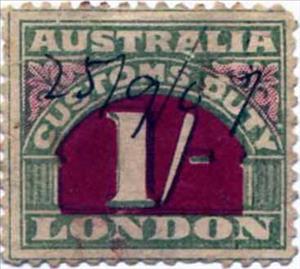Stamp: Customs Duty - London (Australia 1907)
Customs Duty - London (Australia 1907)
01 January (Australia ) within release Customs Duty goes into circulation Stamp Customs Duty - London face value 1 British shilling
| Stamp Customs Duty - London in catalogues | |
|---|---|
| Forbin: | For: AU CD8 |
Stamp is square format.
1st series: - wide outer frame, solid inner frame beneath "LONDON" - with veins in arabesques - letters "ND" of "LONDON" not joined Block-like shading over arabesques (Stone I) Barefoot does not distinguish between the various printings and perforations which exist for this issue.Also in the issue Customs Duty:
- Stamp - Customs Duty - London face value ¼;
- Stamp - Customs Duty - London face value ½;
- Stamp - Customs Duty - London face value 1;
- Stamp - Customs Duty - London face value 2;
- Stamp - Customs Duty - London face value 3;
- Stamp - Customs Duty - London face value 4;
- Stamp - Customs Duty - London face value 8;
- Stamp - Customs Duty - London face value 9;
- Stamp - Customs Duty - London face value 10;
- Stamp - Customs Duty - London face value 11;
- Stamp - Customs Duty - London face value 1;
Stamp Customs Duty - London it reflects the thematic directions:
A number is a mathematical object used to count, measure, and label. The most basic examples are the natural numbers 1, 2, 3, 4, and so forth. Numbers can be represented in language with number words. More universally, individual numbers can be represented by symbols, called numerals; for example, "5" is a numeral that represents the number five. As only a relatively small number of symbols can be memorized, basic numerals are commonly organized in a numeral system, which is an organized way to represent any number. The most common numeral system is the Hindu–Arabic numeral system, which allows for the representation of any non-negative integer using a combination of ten fundamental numeric symbols, called digits. In addition to their use in counting and measuring, numerals are often used for labels (as with telephone numbers), for ordering (as with serial numbers), and for codes (as with ISBNs). In common usage, a numeral is not clearly distinguished from the number that it represents.

